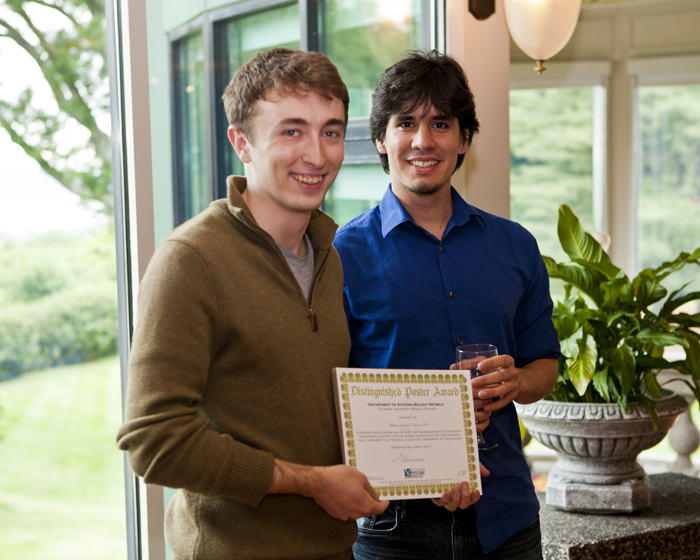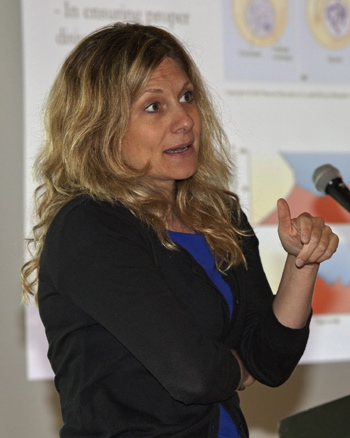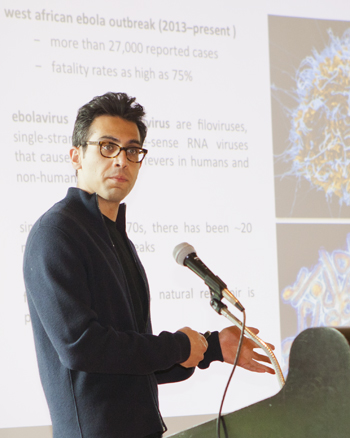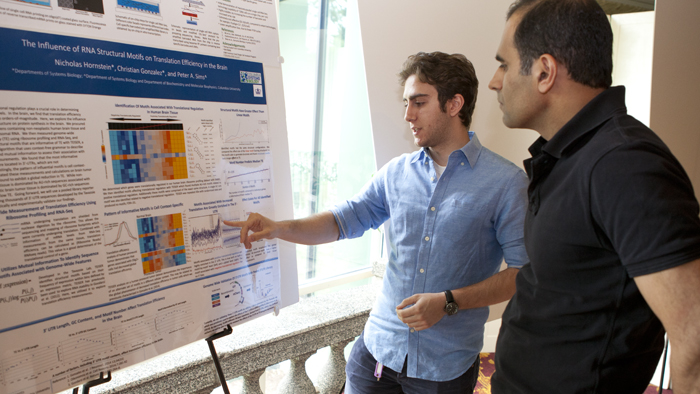News
Department of Systems Biology Annual Retreat Spotlights New Research

Nathan Johns and Antonio Gomes in the Wang Lab received this year's Distinguished Poster Award.
On June 5, 2015, approximately 150 faculty members, postdocs, and graduate students from the Columbia University Department of Systems Biology gathered at the Tappan Hill Mansion in Tarrytown, New York, for a day filled with illuminating presentations and conversations. The meeting has become a high point of the year for the Department, providing a relaxed environment to socialize and learn about some of the newest methods and discoveries emerging from other laboratories.

Molly Przeworski
With the addition of four labs to the Department over the past year, a highlight of the retreat was the opportunity to hear from several of our newest faculty members. Oliver Hobert presented highlights from his recent efforts to identify regulatory motifs that determine neuron and neurotransmitter identity in C. elegans. Rodney Rothstein, speaking just on the heels of being elected to the National Academy of Sciences, discussed how approaches based in yeast genetics can provide insights into synthetic lethality in cancer cells. Molly Przeworski described how she and members of her lab are using perspectives from the field of population genetics to identify genetic factors that define hotspots of meiotic recombination.
For the first time, this year’s retreat also included postdocs and graduate students among the speakers. Yishai Shimoni explained how the Califano Lab is using systems biology approaches to identify master regulators and upstream genomic alterations that drive specific tumor phenotypes found across multiple cancer types. Juan Arriaga discussed how the Abate-Shen Lab is combining CRISPR-based screens with xenografts of human tumors in mouse models in an effort to identify gene alterations that drive metastasis in prostate cancer. Rotem Rubinstein presented work in the Shapiro, Honig, and Maniatis labs that is using structural biology approaches to understand how variation in a class of cell-adhesion proteins called protocadherins enables self-avoidance among dendrites belonging to the same neurons.

Hossein Khiabanian
Hossein Khiabanian opened the afternoon session by presenting work in the Rabadan Lab that is providing insights into clonal expansion in the filoviruses responsible for Marburg disease and the recent Ebola outbreak in West Africa. Hongjian Qi in Yufeng Shen’s lab discussed evidence for de novo mutations that appear to drive both neurodevelopmental disorders and congenital heart disease, suggesting connections between the diseases. Guy Amster in the laboratory of Guy Sella complicated the idea of dating human evolution by the molecular clock hypothesis, arguing that factors such as species-specific gene substitution rates and differences in germ cell mutation rates between males and females could problematize some commonly held assumptions about how to apply it.
Following the talks, a lively poster session offered an opportunity for Department members to share their most recent research. The Distinguished Poster Award was presented to postdoctoral fellow Antonio Gomes and graduate student Nathan Johns, both members of Harris Wang’s lab. Using an approach that combines methods from systems biology and synthetic biology, they are working to understand how horizontal gene transfer occurs between diverse bacterial species. As winners of the Award, they will receive up to $1,000 to support travel to a conference of their choice.

Nick Hornstein, a graduate student researcher in the Sims Lab, explains some recent work to Professor Saeed Tavazoie.